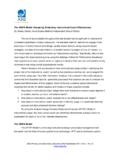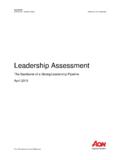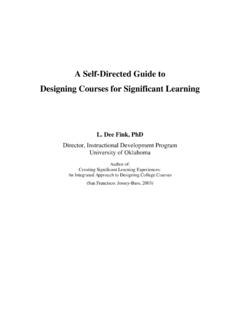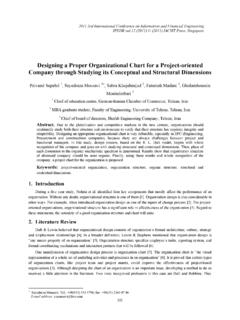Transcription of Designing nutrition-sensitive agriculture investments
1 Designing nutrition - sensitive agriculture investments Checklist and guidance for programme formulation Designing nutrition - sensitive agriculture investments Checklist and guidance for programme formulation Food and agriculture Organization of the United Nations Rome, 2015. This publication has been produced with the assistance of the European Union. The contents of this publication are the sole responsibility of FAO and can in no way be taken to reflect the views of the European Union. The designations employed and the presentation of material in this information product do not imply the expression of any opinion whatsoever on the part of the Food and agriculture Organization of the United Nations (FAO) concerning the legal or development status of any country, territory, city or area or of its authorities, or concerning the delimitation of its frontiers or boundaries.
2 The mention of specific companies or products of manufacturers, whether or not these have been patented, does not imply that these have been endorsed or recommended by FAO in preference to others of a similar nature that are not mentioned. The views expressed in this information product are those of the author(s) and do not necessarily reflect the views or policies of FAO. ISBN 978-92-5-108935-4. FAO, 2015. FAO encourages the use, reproduction and dissemination of material in this information product. Except where otherwise indicated, material may be copied, downloaded and printed for private study, research and teaching purposes, or for use in non-commercial products or services, provided that appropriate acknowledgement of FAO as the source and copyright holder is given and that FAO's endorsement of users' views, products or services is not implied in any way.
3 All requests for translation and adaptation rights, and for resale and other commercial use rights should be made via or addressed to FAO information products are available on the FAO website ( ) and can be purchased through Contents Foreword v Acknowledgements vii Introduction 1. Key Recommendations for Improving nutrition through agriculture and Food Systems 4. Situation appraisal 7. Institutional, policy and programme context 7. The nutritional situation in the country/programme area 9. Health and sanitation environment, including food safety 11. Food consumption patterns and dietary needs 13. Food availability and seasonality 15. Household access to food 16. Gender and care practices 18. Access to productive assets and marketing opportunities: equity issues 19. Policy frameworks and regulations 20. Programme Design: Operationalizing the Key Recommendations 23.
4 Defining project objectives and impact indicators 23. Target areas and populations and equity considerations 28. Linking to other programmes and sectors 30. Maintaining and improving the natural resource base 32. Gender considerations and women's empowerment 34. Programme options to increase access to diverse and nutritious foods 36. Improving processing, storage and preservation 39. Making value-chains nutrition - sensitive and increasing market access 41. Incorporating nutrition education and consumer awareness 44. Programme document review 49. Foreword Economic growth and social protection mechanisms have helped pull many out of poverty in recent decades, and this was accompanied by a marked reduction in food insecurity. However, the prevalence of child undernutrition remains unacceptably high and is compounded by rising levels of obesity and diet-related chronic diseases.
5 In November 2014, during the Second International Conference on nutrition (ICN2) organized by the Food and agriculture Organization of the United Nations (FAO) and the World Health Organization (WHO), over 170 member countries acknowledged that malnutrition, in all its forms (including undernutrition, micronutrient deficiencies, overweight and obesity), negatively affects people's health and well-being and poses high economic and social costs for individuals, communities and nations. The two ICN2 outcome documents: the Rome Declaration on nutrition and its Framework for Action, recognize that food systems should be at the heart of efforts to combat all forms of malnutrition. Current food systems are increasingly challenged to provide adequate, safe, diversified and nutrient-rich food that make up healthy diets due to constraints posed by resource scarcity and environmental degradation, as well as unsustainable production and consumption patterns, food losses and waste, and inequitable distribution.
6 investments in agriculture and food systems are therefore essential to improve the availability, accessibility and consumption of nutritious foods. These investments come from international financing institutions, public resources at the country level and, most importantly, from farmers themselves and the private sector in general. They can be leveraged in favor of nutrition but doing so requires explicitly considering the nutritional implications of investments . Efforts should be made to: diversify production and diets; improve processing methods to make healthy foods available longer and convenient to prepare;. and ensure that investments are equitable and mindful of the environment. Furthermore, resources should be invested in nutrition education in order to empower consumers to make healthy food choices. v Designing nutrition - sensitive agriculture investments FAO member countries and their development partners are increasingly seeking to meet national and international commitments and are therefore looking to concrete tools and field experiences.
7 Since 2011, FAO's nutrition Division (ESN) and Technical Cooperation and investment Center (TCI) have been increasingly working together to respond to this need and enhance the nutrition sensitivity of FAO's investment support. The purpose of this collaboration is to assist governments and international finance institutions in ensuring that their investments are nutrition - sensitive and maximize impact on human well-being while being mindful of environment. This collaboration has led to the development of tools to guide the design of nutrition - sensitive programmes including the present guidelines. This document is based on a thorough review of experience on nutrition - sensitive agriculture . It was developed through extensive consultation within FAO and with its development partners, and has been field-tested in several countries.
8 It is a living document and so we look forward to continued collaboration with our partners in learning how to improve the contribution of agriculture investments to better nutrition . Anna Lartey Gustavo Merino Director Director nutrition Division investment Center FAO FAO. vi Acknowledgements This guidance checklist has been developed jointly by FAO's nutrition Division (ESN) and investment Centre (TCI). The main authors are Anna Herforth (FAO consultant), Charlotte Dufour (FAO nutrition Policy and Programme Officer, ESN), and Anna-Lisa Noack (FAO nutrition - sensitive investment consultant, TCI). The checklist builds on group work guidance developed for the African Union (AU) and New Partnership for African Development (NEPAD) CAADP nutrition Capacity Development Initiative regional workshops. It was reviewed through several consultation processes with FAO's investment Centre, FAO's nutrition Division and the Ag2 Nut Community of Practice.
9 The authors particularly acknowledge contributions from Johanna Jelensperger (FAO agriculture Economics Division), Benoist Veillerette (FAO TCI), Pamela Pozarny (FAO TCI), Domitille Kauffmann (ESN), Ruth Charrondi re (ESN), Yenory Hernandez Garbanzo (ESN), Florence Tonnoir (ESN), Nomeena Anis (FAO Pakistan), Lalita Bhattacharjee (FAO Bangladesh), Heather Danton (USAID SPRING) and Andrea Spray (World Bank Group). Finally, the support of Jayne Beaney, editor, Juan Luis Salazar, graphic artist, and Chiara Deligia, communication officer (ESN) are warmly acknowledged. The development of this guidance checklist was made possible with support from the Federal Republic of Germany, the European Union through the Improved Global Governance for Hunger Reduction Programme, and the Bill and Melinda Gates Foundation. vii Introduction The persistence of high levels of undernutrition manifested in high rates of chronic and acute undernutrition as well as micronutrient deficiencies combined with an increasing prevalence of overweight and chronic disease, has led to unprecedented political commitment to address malnutrition through multisectoral and multistakeholder efforts.
10 In November 2014, during the Second International Conference on nutrition (ICN2), FAO and WHO Member States reaffirmed their commitment to combat all forms of malnutrition through the adoption of the Rome Declaration on nutrition and its Framework for Action. The ICN2. Framework for Action emphasizes the importance of reviewing national policies and investments and integrating nutrition objectives into food and agriculture policy, programme design and implementation . Food systems are indeed primarily responsible for feeding people well by increasing availability, affordability and consumption of diverse, safe, culturally appropriate, nutritious foods and diets without harming the environment. A growing number of institutions investing in food systems have committed themselves to ensuring their investments are nutrition - sensitive , but many professionals from the food and agriculture sector seek guidance on what this entails in terms of programme design and implementation.
















